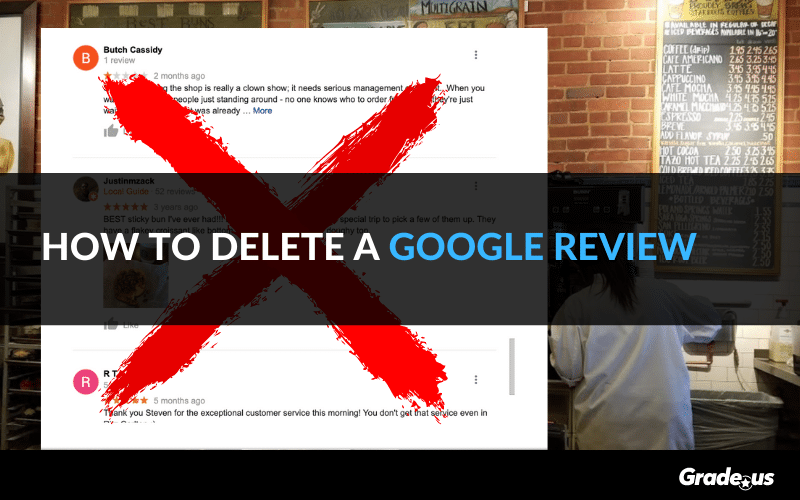Research shows it takes close to 40 positive customer experiences to undo the damage of a single negative review. You’ve just received a negative review in Google review.
What’s worse, the review is inaccurate or fraudulent.
What’s the best way to delete a Google Review? It’s easy for individual reviewers, but is it possible for business owners to remove bad reviews? It’s doable with consistent effort. Today I’ll share a step-by-step process you can use to do just that.
Table of Contents
Get the Reputation You Deserve with Grade.us
Can you delete Google reviews?
Google’s policy is clear on this.
They provide business owners with ten types of reviews that are listed as prohibited and restricted content. Google states that these inappropriate reviews are automatically processed; they state that they take down reviews that are ‘flagged in order to comply with Google policies or legal obligations.’
These review types are listed as follows:
- Spam and fake content: Fake content about a customer’s experience, sharing the same content multiple times, or posting content for the same business or location from multiple Google accounts.
- Off-topic: Reviews that are used to rant about social, religious, political, or personal issues are prohibited on Google Maps.
- Restricted content: This could be content that violence local or regional regulations —reviews of restricted products or services, contact information for restricted products or services, links to websites listing restricted products.
- Illegal content: This is content that depicts illegal activity – violence, human trafficking, drug dealing, content produced on behalf of or by hate groups, etc.
- Terrorist content: This is fairly obvious but this refers to any review that promotes terrorism in the form of threats, celebration of specific acts, recruitment, incitement, etc.
- Sexually explicit content: Reviews that contain sexually explicit content (e.g., insults, descriptions, materials, etc.).
- Offensive content: Any content that contains profane, offensive, explicit, or obscene language or gestures. If reviewers are using offensive language you can flag their review.
- Dangerous and derogatory content: This includes bullying, discrimination, threats, harassment, intimidation, or inciting hatred.
- Impersonation: falsely representing yourself as an individual, representative of a company or organization. This includes pretending to be someone else, an employee of the company being reviewed, or a Google employee.
- Conflicts of interest: This includes writing reviews about your own business or a competitor’s business to manipulate their review ratings. Or with reviewers posting content about their current or former employer.
This is a good thing.
It means reviewers are required to share content that meets a very narrow set of criteria. Any review that ventures into prohibited or restricted territory can be removed. Why is this important for your business?
Google doesn’t catch everything.
In fact, if you read through their help article on prohibited and restricted content you’ll see that Google admits this themselves.
“We may take down reviews that are flagged in order to comply with Google policies or legal obligations.”
What does this mean?
According to Mike Blumenthal, founder of GatherUp and a Google Gold Product Expert, Google doesn’t have the ability to authenticate online reviews.
Think about it.
Google accounts for 57.5 percent of all reviews worldwide, across all review platforms. That’s far too many reviews to authenticate even if they wanted to. This means it’s a good idea to go through your review portfolio on Google and flag all of the reviews that fail to meet the criteria above.
Here’s another unpleasant detail.
Google Local doesn’t limit reviews to customers. This means non-customers can write reviews about your business as well, which is kind of unfair. Here’s how Blumenthal describes it:
“Google encourages you to ask your own customers for reviews and but in Google Local, I know of no interest of theirs to limit reviews to only actual customers.”
This is why removing bad reviews on Google is so important.
How to delete a Google review
Google isn’t really all that forthcoming about their process. If you think about it, this makes sense. At first glance, it seems like the reasonable thing to do would be to state things clearly however, that would create an opportunity for abuse.
The more detailed the process, the easier it is for others to manipulate.
Here’s why this matters.
Going through the steps I’m about to share isn’t a surefire guarantee that you’ll be able to delete an unsavory review. It’s best practices and it’s reasonable to hope that things will work out. With that in mind, here are the steps you can take to remove bad reviews.
- Sign in to your Google account
- Head over to Google Maps
- Search for your business in Google Maps
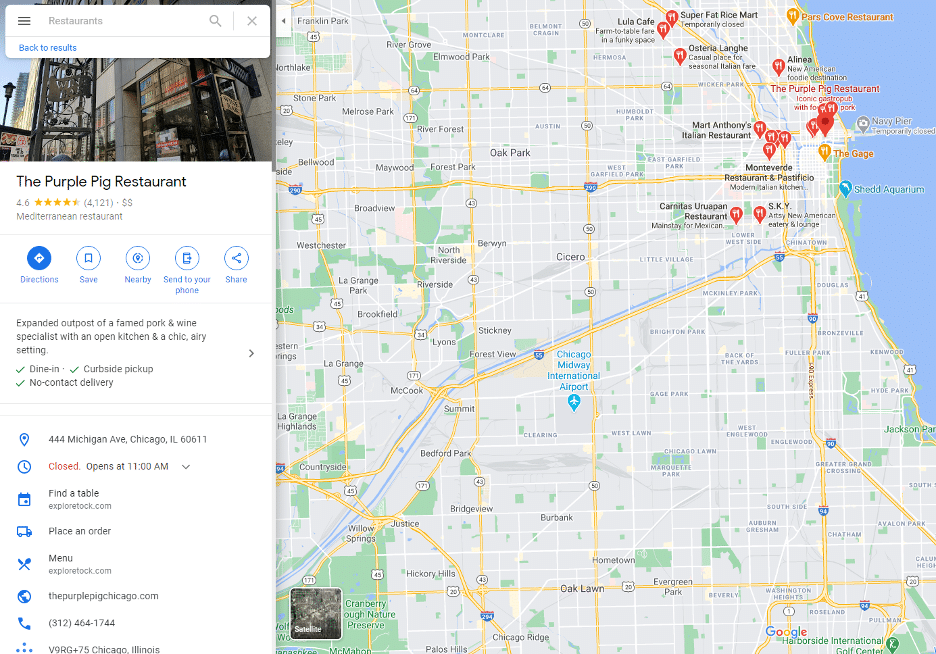
- Click the stars/number of reviews to expand the reviews
- Scroll down to the offending review, click the three-dot menu icon on the offending review
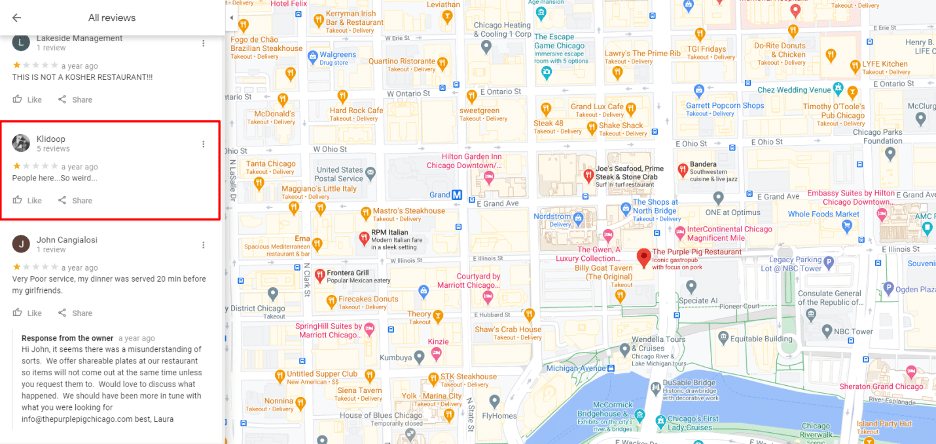
- Click the “Flag as inappropriate” link
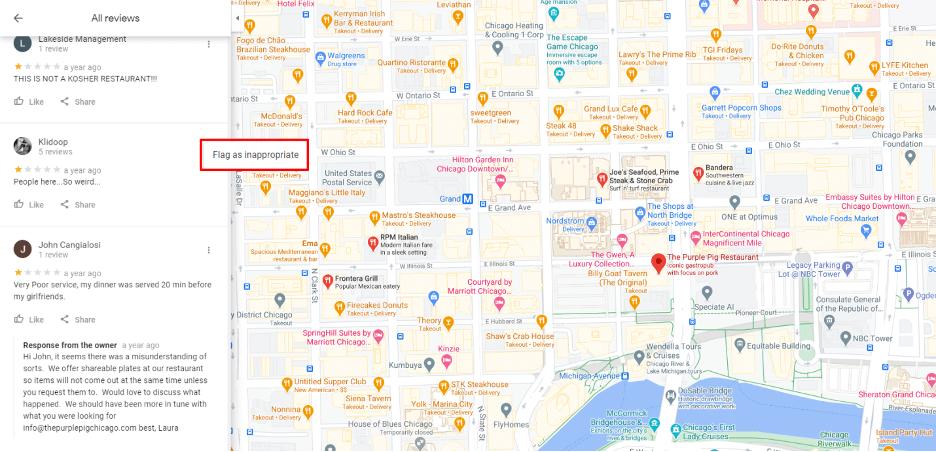
- Fill out the policy violation form then click Report
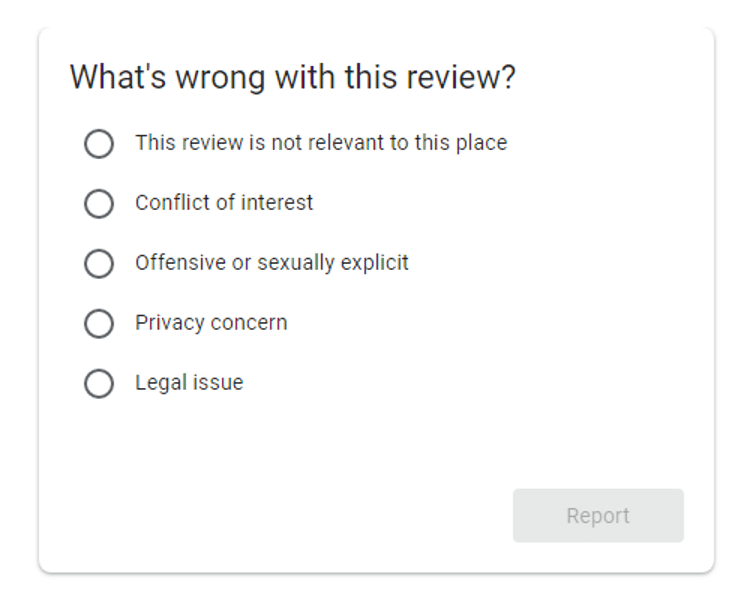
- Google will follow up for clarification if needed

See what I mean?
Their policy isn’t particularly clear. You’re not sure whether things will work out in your favor or not. What if it doesn’t work out for your business? There’s another option available to you. Here’s how you do it.
- Sign in to your Google My Business account
- Click the reviews tab, scroll to the offending review, then click the three-dot menu
- Select “Flag as Inappropriate“
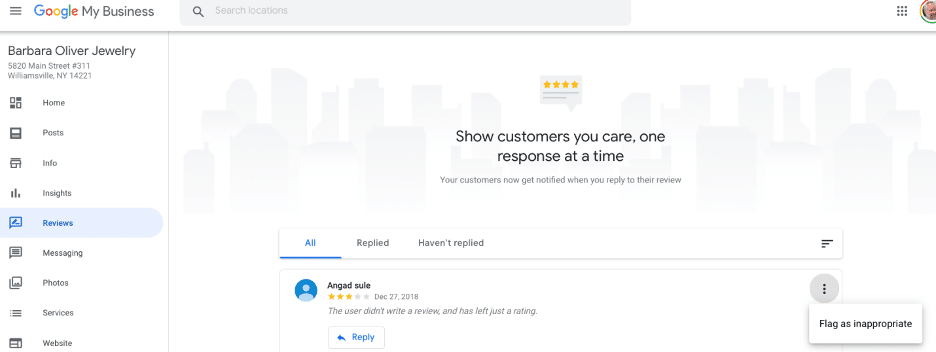
If Google agrees with you, these reviews should disappear in time.
In March of 2021, Google released a new tool that allows business owners to keep track of reported Google reviews (H/T to Joy Hawkins of Sterling Sky for the discovery). You can now view all of your reported reviews in one place and keep track of their status so you don’t have to manually track the reported reviews yourself.
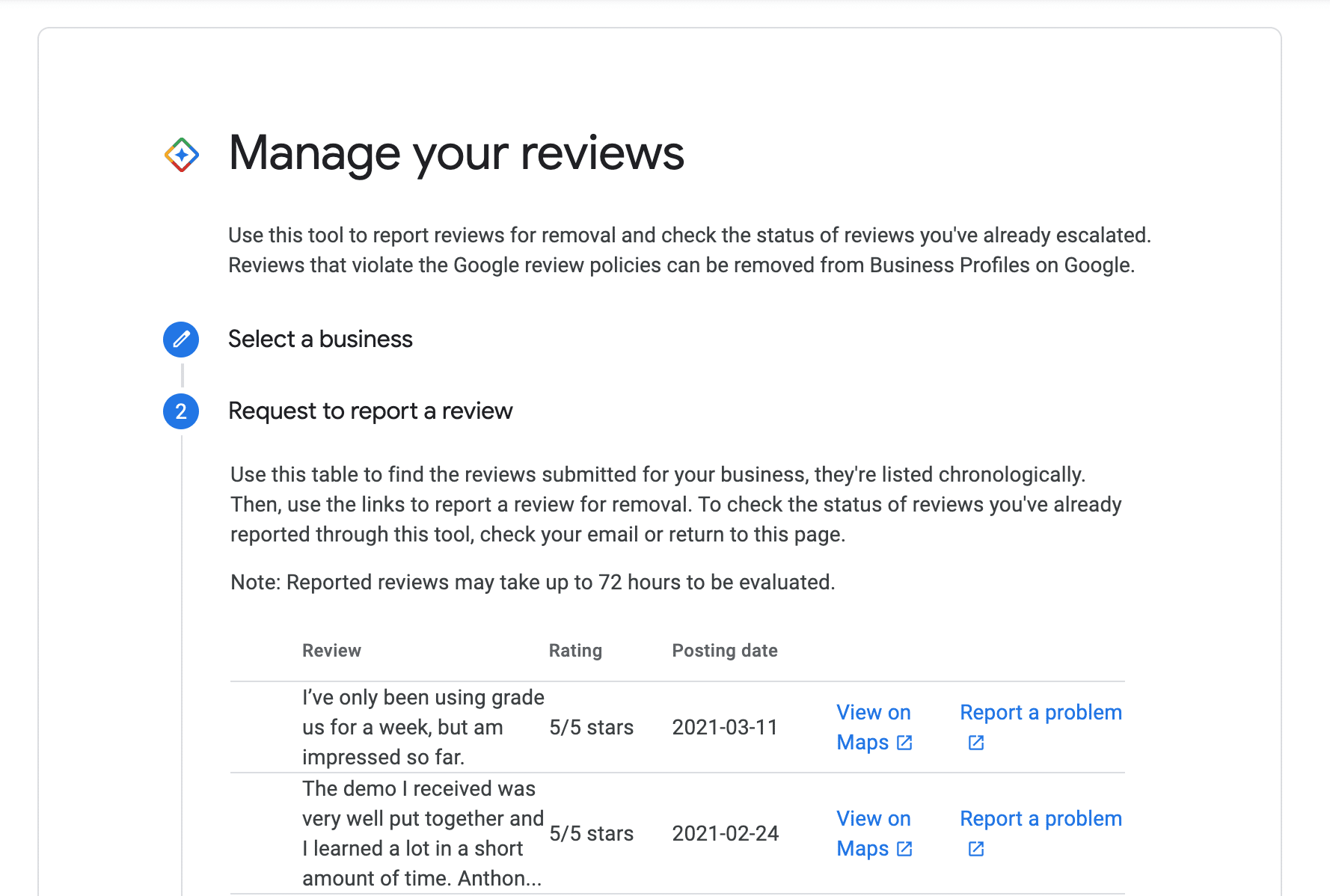
You can then go back and check the removal status of the review you have reported. Hopefully, this improves the way Google handles review moderations and their transparency around the process.
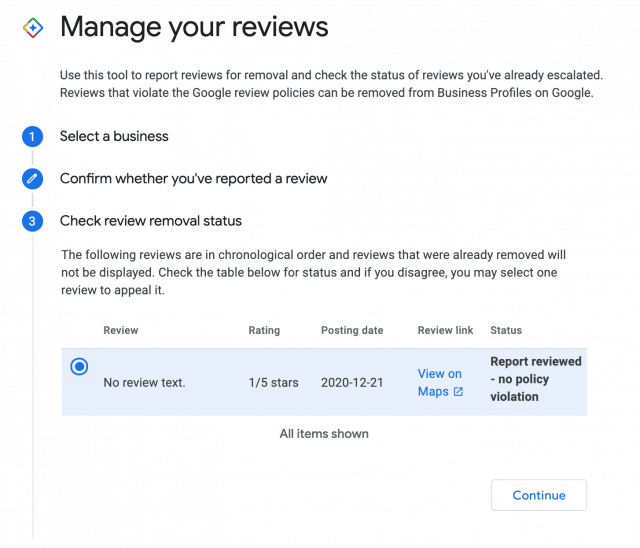
When can you delete Google reviews?
There are several triggers you can use as indicators, outlining when it’s time to remove a bad review. Here are several triggers you can watch for.
- Misguided and unhappy: These reviewers post factually incorrect information. They believe they’re right and they’re unwilling to accept criticism that says otherwise.
- SJW Faux pas: These reviewers make political, social, religious, or ideological stands against your business; they decide that it’s their right to punish or cancel your business via an online review mob for a perceived slight.
- Dysfunctional reviewers: Unethical reviewers, trolls, ragers, or insecure customers are good indicators of reviews you’ll need to monitor.
- Review blackmail: A criminal makes an unreasonable demand or extorts resources from your business. These reviewers demand payment; in exchange, they’ll avoid posting libelous and fraudulent reviews about your business.
What if the reviewer has legitimate concerns or complaints?
That’s easy.
- Ask your reviewer for a chance to make things right
- Then, once you’ve made things right, ask them to update their review
Here’s the process in action.
- Create a list of negative reviews. You’re looking for unhappy customers with a genuine grievance who decided to leave a negative review. Disregard any of the inappropriate review types mentioned above.
- Ask these customers for a second chance. You're looking for customers who are willing to help you set things right. If these unhappy customers aren't interested, let things go.
- Make the relationship right. Do what takes to fix the problems of the past. Roll out the red carpet, verify that their headaches have been resolved.
- Confirm that the relationship has been restored. You'll want to verify that your customers are satisfied, happy. This is a feeling out process that's designed to focus exclusively on the customer. Don't mention reviews at all in this step.
- Ask your customer to update their review. Make sure they know that it's okay to say No. If they're not interested in updating their review, leave the relationship as is until they're ready to return. If they are willing to write a review, make it easy and convenient.
Makes sense? Good.
Here’s a “delete a review template” your agency can share with clients. Use this template to help your clients recover unhappy customers.
Deleting Google reviews is a simple process
But it requires patience and persistence.
As we’ve seen, deleting reviews from your review profile is straightforward. If a segment of your reviewers have crossed the line, you can (and should) flag their reviews as inappropriate. Follow the step-by-step process I’ve shared and you’ll find it’s easier to delete these troublesome reviews.
What about reviews from unhappy customers?
Ask them for a second chance. With the right offer, and a willingness to turn things around, you’ll find you’re able to restore relationships that matter. Restore unhappy customers and you’ll find you can undo the damage of a single review.

